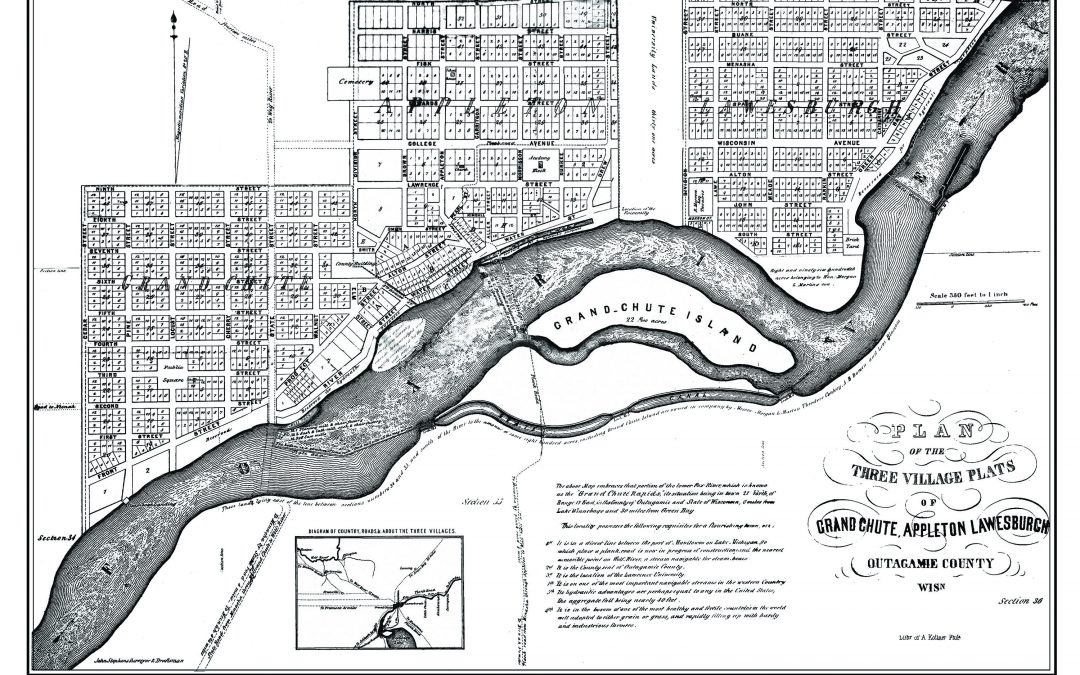What’s In an Appleton Street Name?
by Gwen Hinz Sargeant

Have you ever driven, bicycled, or walked around Appleton and wondered, “Where did that street name come from?” Appleton is made up of an extensive network of streets and avenues. To understand how Appleton’s streets and avenues developed, it requires review of the history of Appleton’s first days.
In 1846, Amos Lawrence pledged $10,000 to build a University in the woods. The first streets built in Appleton were those surrounding the original Lawrence Institute in the Appleton Plat.
In August of 1848, Reverend Sampson, Reeder Smith, Captain Henry Blood, and surveyor Joel S. Wright laid out the plat. The academy block was surrounded by College, Durkee, Morrison, and Lawrence Streets. The first streets in Appleton were named for Lawrence college donors.
College Avenue was a dusty block of stumps, in those days named for the University in the Woods. Durkee Street was named for Charles Durkee, an early donor to the College. Morrison Street was named for Arch M. Morrison, who gave $500. Lawrence Street was named for thee afore mentioned, Amos Lawrence.
The original institute building was located where the downtown YMCA is today. The 1853 map of the city of Appleton was a combination of the 3 villages: Grand Chute, Appleton, and Lawesburg. In the Appleton plat, in addition to the previously mentioned streets, the plat also included location-based street names and other Lawrence contributors and engineers. Examples include North Division, named for the boundary between the Appleton and Grand Chute plats, and South Division, named for the boundary between Appleton and Lawesburg plats. South Division was renamed Union Street by 1857. Drew Street was named for Daniel Drew, a donor to Lawrence Institute and President of the Erie railroad. Kimball Street was named for Reeder Smith’s wife, Eliza Pierce Kimball.
The street with the most name changes in Appleton plat was Edwards. It is likely to have been named after Nathaniel Marsh Edwards, an early surveyor. Edwards Street was changed to Adkins, for the wealthy Charles G. Adkins, a merchant who came to Appleton in 1853. The same street saw its final name change in 1925 when it became Washington.
To the East of Appleton Plat lies Lawesburg Plat. Lawesburg plat was owned by Judge George Lawe. The streets in Lawesburg were named for George Lawe’s family, friends, locations, and some Native American words. Examples include Green Bay Street, named for the old Indian Trail route to Green Bay, Lawe Street, named for George’s surname, and Meade Street, named for Catherine Meade Lawe, George’s wife.
Nawada is a Native American word said to mean sweet singer. Leminwah is a Native American word for deer trail or deer run. Opeechee is a Native American word that means robin.
The Grand Chute plat was located to the West of the Appleton Plat. Grand Chute Plat was almost named Martinville, in honor of the majority land holder Judge Morgan L. Martin. Martin, Blood, Bateman, and Warner made up the committee to plat Grand Chute. The streets in Grand Chute plat were named for trees, proximity to the river, family names, and numbers ascending from the river north. Prospect was named for the view of the river. First, Second, Third, Fourth, Fifth, Sixth, Seventh, Eighth, and Ninth are all named in order from the river. Ninth no longer retains its name. It was changed to Lawrence after the plats were aligned. Elm, Walnut, Cherry, Locust, Pine, and Cedar were all named for trees.
The three plats were combined in 1857 when the area became officially the City of Appleton.



